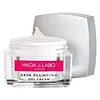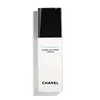What's inside
What's inside
 Key Ingredients
Key Ingredients

 Benefits
Benefits

 Concerns
Concerns

 Ingredients Side-by-side
Ingredients Side-by-side

Water
Skin ConditioningButylene Glycol
HumectantGlycerin
HumectantHydroxyethyl Urea
HumectantPentylene Glycol
Skin ConditioningPPG-10 Methyl Glucose Ether
Skin ConditioningTriethylhexanoin
MaskingSqualane
EmollientDimethicone
EmollientAmmonium Acryloyldimethyltaurate/Vp Copolymer
PPG-17-Buteth-17
Skin ConditioningTriethyl Citrate
MaskingBehenyl Alcohol
EmollientPhenoxyethanol
PreservativePropanediol
SolventSodium Citrate
BufferingSodium Hyaluronate
HumectantXanthan Gum
EmulsifyingDisodium EDTA
Citric Acid
BufferingCaprylhydroxamic Acid
Hydrolyzed Hyaluronic Acid
HumectantSodium Acetylated Hyaluronate
HumectantTocopherol
AntioxidantLecithin
EmollientAscorbyl Palmitate
AntioxidantHydrolyzed Collagen
EmollientHydrogenated Vegetable Glycerides Citrate
EmollientAphanothece Sacrum Polysaccharide
AbsorbentAlcohol Denat.
AntimicrobialHydroxypropyltrimonium Hyaluronate
Phospholipids
Skin ConditioningPotassium Sorbate
PreservativeSphingolipids
EmollientBenzoic Acid
MaskingSorbic Acid
PreservativeWater, Butylene Glycol, Glycerin, Hydroxyethyl Urea, Pentylene Glycol, PPG-10 Methyl Glucose Ether, Triethylhexanoin, Squalane, Dimethicone, Ammonium Acryloyldimethyltaurate/Vp Copolymer, PPG-17-Buteth-17, Triethyl Citrate, Behenyl Alcohol, Phenoxyethanol, Propanediol, Sodium Citrate, Sodium Hyaluronate, Xanthan Gum, Disodium EDTA, Citric Acid, Caprylhydroxamic Acid, Hydrolyzed Hyaluronic Acid, Sodium Acetylated Hyaluronate, Tocopherol, Lecithin, Ascorbyl Palmitate, Hydrolyzed Collagen, Hydrogenated Vegetable Glycerides Citrate, Aphanothece Sacrum Polysaccharide, Alcohol Denat., Hydroxypropyltrimonium Hyaluronate, Phospholipids, Potassium Sorbate, Sphingolipids, Benzoic Acid, Sorbic Acid
Water
Skin ConditioningCamellia Japonica Flower Water
Skin ConditioningSqualane
EmollientGlycerin
HumectantAlcohol
AntimicrobialLauroyl Lysine
Skin ConditioningPropanediol
SolventCanola Oil
EmollientPentylene Glycol
Skin ConditioningDimethicone
EmollientZingiber Officinale Root Extract
MaskingCamellia Japonica Flower Extract
EmollientPEG-60 Glyceryl Isostearate
Ammonium Acryloyldimethyltaurate/Vp Copolymer
Dimethicone Crosspolymer
Emulsion StabilisingParfum
MaskingCaprylyl Glycol
EmollientSodium Acrylates/C10-30 Alkyl Acrylate Crosspolymer
Silica
AbrasiveArginine
MaskingDipropylene Glycol
HumectantPhenoxyethanol
PreservativePolyquaternium-51
Skin ConditioningSodium Hyaluronate
HumectantTocopheryl Acetate
AntioxidantPhytic Acid
Ascorbyl Glucoside
AntioxidantSodium Citrate
BufferingSodium Benzoate
MaskingCitric Acid
BufferingCI 77891
Cosmetic ColorantMica
Cosmetic ColorantWater, Camellia Japonica Flower Water, Squalane, Glycerin, Alcohol, Lauroyl Lysine, Propanediol, Canola Oil, Pentylene Glycol, Dimethicone, Zingiber Officinale Root Extract, Camellia Japonica Flower Extract, PEG-60 Glyceryl Isostearate, Ammonium Acryloyldimethyltaurate/Vp Copolymer, Dimethicone Crosspolymer, Parfum, Caprylyl Glycol, Sodium Acrylates/C10-30 Alkyl Acrylate Crosspolymer, Silica, Arginine, Dipropylene Glycol, Phenoxyethanol, Polyquaternium-51, Sodium Hyaluronate, Tocopheryl Acetate, Phytic Acid, Ascorbyl Glucoside, Sodium Citrate, Sodium Benzoate, Citric Acid, CI 77891, Mica
 Reviews
Reviews

Ingredients Explained
These ingredients are found in both products.
Ingredients higher up in an ingredient list are typically present in a larger amount.
Ammonium Acryloyldimethyltaurate/Vp Copolymer (let's call it AAVC for short) is a synthetically created polymer. It's used as a film-forming agent and used to thicken the consistency of products.
AAVC is able to increase the consistency and viscosity of products due to its large molecule size. It also prevents ingredients from separating.
Citric Acid is an alpha hydroxy acid (AHA) naturally found in citrus fruits like oranges, lemons, and limes.
Like other AHAs, citric acid can exfoliate skin by breaking down the bonds that hold dead skin cells together. This helps reveal smoother and brighter skin underneath.
However, this exfoliating effect only happens at high concentrations (20%) which can be hard to find in cosmetic products.
Due to this, citric acid is usually included in small amounts as a pH adjuster. This helps keep products slightly more acidic and compatible with skin's natural pH.
In skincare formulas, citric acid can:
While it can provide some skin benefits, research shows lactic acid and glycolic acid are generally more effective and less irritating exfoliants.
Most citric acid used in skincare today is made by fermenting sugars (usually from molasses). This synthetic version is identical to the natural citrus form but easier to stabilize and use in formulations.
Read more about some other popular AHA's here:
Learn more about Citric AcidDimethicone is a type of synthetic silicone created from natural materials such as quartz.
What it does:
Dimethicone comes in different viscosities:
Depending on the viscosity, dimethicone has different properties.
Ingredients lists don't always show which type is used, so we recommend reaching out to the brand if you have questions about the viscosity.
This ingredient is unlikely to cause irritation because it does not get absorbed into skin. However, people with silicone allergies should be careful about using this ingredient.
Note: Dimethicone may contribute to pilling. This is because it is not oil or water soluble, so pilling may occur when layered with products. When mixed with heavy oils in a formula, the outcome is also quite greasy.
Learn more about DimethiconeGlycerin is already naturally found in your skin. It helps moisturize and protect your skin.
A study from 2016 found glycerin to be more effective as a humectant than AHAs and hyaluronic acid.
As a humectant, it helps the skin stay hydrated by pulling moisture to your skin. The low molecular weight of glycerin allows it to pull moisture into the deeper layers of your skin.
Hydrated skin improves your skin barrier; Your skin barrier helps protect against irritants and bacteria.
Glycerin has also been found to have antimicrobial and antiviral properties. Due to these properties, glycerin is often used in wound and burn treatments.
In cosmetics, glycerin is usually derived from plants such as soybean or palm. However, it can also be sourced from animals, such as tallow or animal fat.
This ingredient is organic, colorless, odorless, and non-toxic.
Glycerin is the name for this ingredient in American English. British English uses Glycerol/Glycerine.
Learn more about GlycerinPentylene glycol is typically used within a product to thicken it. It also adds a smooth, soft, and moisturizing feel to the product. It is naturally found in plants such as sugar beets.
The hydrophilic trait of Pentylene Glycol makes it a humectant. As a humectant, Pentylene Glycol helps draw moisture from the air to your skin. This can help keep your skin hydrated.
This property also makes Pentylene Glycol a great texture enhancer. It can also help thicken or stabilize a product.
Pentylene Glycol also acts as a mild preservative and helps to keep a product microbe-free.
Some people may experience mild eye and skin irritation from Pentylene Glycol. We always recommend speaking with a professional about using this ingredient in your routine.
Pentylene Glycol has a low molecular weight and is part of the 1,2-glycol family.
Learn more about Pentylene GlycolPhenoxyethanol is a preservative that has germicide, antimicrobial, and aromatic properties. Studies show that phenoxyethanol can prevent microbial growth. By itself, it has a scent that is similar to that of a rose.
It's often used in formulations along with Caprylyl Glycol to preserve the shelf life of products.
Propanediol is an all-star ingredient. It softens, hydrates, and smooths the skin.
It’s often used to:
Propanediol is not likely to cause sensitivity and considered safe to use. It is derived from corn or petroleum with a clear color and no scent.
Learn more about PropanediolSodium Citrate is the sodium salts of citric acid. In skincare, it is used to alter pH levels and acts as a preservative.
Its main functions are to maintain the pH of a product and neutralize metal ions.
The acidity of our skin is maintained by our glands and skin biome; normal pH level of skin is slightly acidic (~4.75-5.5).
Being slightly acidic allows our skin to create an "acid mantle". This acid mantle is a thin barrier that protects our skin from bacteria and contaminants.
Learn more about Sodium CitrateSodium Hyaluronate is hyaluronic acid's salt form. It is commonly derived from the sodium salt of hyaluronic acid.
Like hyaluronic acid, it is great at holding water and acts as a humectant. This makes it a great skin hydrating ingredient.
Sodium Hyaluronate is naturally occurring in our bodies and is mostly found in eye fluid and joints.
These are some other common types of Hyaluronic Acid:
Learn more about Sodium HyaluronateSqualane is an emollient that helps the skin hold onto moisture. It's an oily liquid that occurs naturally in certain types of fish and plant oils.
Because squalane boosts hydration in the skin, it also comes with plenty of benefits: it is an antioxidant and can help fight free radicals and skin damage. Squalane is also found to have a detoxifying effect when applied.
Squalane comes from squalene, which occurs naturally within the sebum of our skin. It is one of the oils our skin produces to keep itself hydrated. Squalane is the hydrogenated version of squalene and has a longer shelf life.
Research shows that squalane is non-irritating (even at 100% concentration).
In general, it's a fantastic ingredient. It does a great job at hydrating the skin, and it's suitable for those with sensitive skin.
The source of squalane may impact malassezia / fungal acne. This is because olive oil derived squalane can contain impurities such as fatty acids and plant waxes. Sugarcane derived squalane is recommended for anyone with malassezia concerns.
Is squalane vegan?
This depends on the source. Squalane can be derived from both plants and animals. Most squalane used in skincare comes from plants.
Please note: the source of squalane is only known if disclosed by the brand. We recommend reaching out to the brand if you have any questions about their squalane.
Read more about squalene with an "e".
Is squalane an oil?
Squalane is often called an oil, but it’s technically not; it’s a hydrocarbon, meaning it’s only made of carbon and hydrogen, unlike true oils which are triglycerides made of fatty acids and glycerol.
The term “oil-free” isn’t regulated, so companies can define it however they want. Some exclude all oils, while others just avoid mineral oil or comedogenic oils.
While some people avoid oils thinking they cause breakouts, the right kind of oil (or oil-like ingredient like squalane) can actually help balance and hydrate your skin. It’s worth testing out simple oils or squalane to see what works best for your skin.
Learn more about SqualaneWater. It's the most common cosmetic ingredient of all. You'll usually see it at the top of ingredient lists, meaning that it makes up the largest part of the product.
So why is it so popular? Water most often acts as a solvent - this means that it helps dissolve other ingredients into the formulation.
You'll also recognize water as that liquid we all need to stay alive. If you see this, drink a glass of water. Stay hydrated!
Learn more about Water